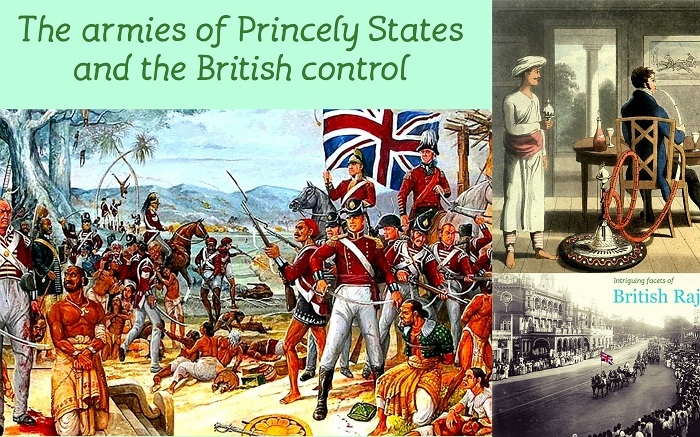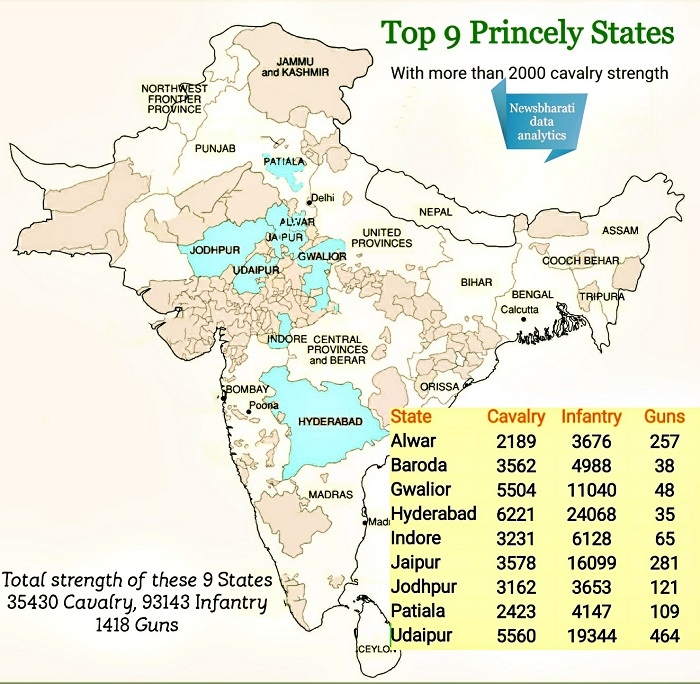The armies of Princely States and the british control
The comprehensive measures of the empire to control the military forces of Princely States
Total Views |

The East India company, initially reluctantly and later hesitantly, increased the footprint of their empire. In the expansion process knowbody knew the end of the story and therefore many ad-hoc steps were taken. Each war victory was followed by a treaty. A plethora of treaties and Sanads gave rise to the phenomenon of about 600 Princely States. As war treaties are always in the favor of victors, these treaties included several restrictions on the defeated Princely States. The paramount restriction was about the strength of the army these Princes were allowed to maintain. In those days, having a cavalry, infantry and artillery were the essential features of a full fledged army. As we have seen in the first article of the series Princely States: a data analysis almost 350 States were too small to afford their own army. According to the treaties, 98 out of about 250 bigger States had the privilege to maintain their own army.
Armies of Princely States at a glance
The combined strength of all these 98 States in year 1896 was 55204 cavalry, 185729 infantry, 4507 guns.
The strength of British army upto 1885 was, Queen's army, consisting of 63000 British soldiers and officers, the three sepoy armies of Bengal, Madras, and Bombay consisting of 125000 Indian soldiers (slightly earlier data of 1865 tells us the composition as 42 cavalry regiments, 142 infantry regiments and 9 artillery batteries. This proportion most likely continued till 1885) and 900 Artillery exclusively under control of British soldiers. This was more or less in accordance with the principles of military organization established by the Peel Commission of 1859 to prevent the recurrence of armed rebellion in India. Its main recommendations were that a permanent British force of 80,000 had to be stationed in India; the military ratio of Indian troops to European troops be fixed as two to one for Bengal and three to one for both Madras and Bombay; and that artillery should be mainly a European force.
If we consider the regional distribution, the Princely armies had a heavy presence in the Rajputana and Maratha kingdoms.

The rebellion of 1857 was scary for the British not just because of the rebel troops but for the fear of Rajput and Maratha Princes uniting to join the rebels, which did not happen. Thereafter the strategy was not to allow these forces to come together, to keep them inferior in terms of technology and to deploy counter balancing forces at strategic places.
The restrictive treaties
Many restrictions were deviced and enhanced over the period for this purpose in treaties. The imperial gazetteer summarized these restrictions as
"The treaties with most of the larger States are clear on this point. Posts in the interior must not be fortified, factories for the production of guns and ammunition must not be constructed, nor may the subject of other States be enlisted in the local forces. ... They must allow the forces that defend them (i.e. the British army) to obtain local supplies, to occupy cantonments or positions, and to arrest deserters; and in addition to these services they must recognise the Imperial control of the railways, telegraphs, and postal communications as essential not only to the common welfare but to the common defence."
The following selected points from the various treaties give idea about the meaning of the above summary and further restrictions.
• Not to employ Europeans without the consent of the British Government, even for civilian duties.
• Prohibiting the employment of foreign mercenaries, Arabs, Abyssinians, or Vilayatis.
• Where any of these States possessed access to the sea, the Company either acquired control over their ports as over Porbandar In 1809, or Imposed restrictions on their trade. Thus the Kutch state agreed in 1819 that no foreign vessels -American, European, or Asiatic- shall be allowed to import into the territory of Kutch arms or military stores.
• Thus in the Kolhapur Treaty, in 1829, the admission of British garrisons into the forts of Kolhapur and Panalla was required "as security for future good conduct."
• Several provisions to ensure supply lines for British army. The States were bound to supply to British garrisons " such quantities of grain and Benjarees as his resources may afford"; "to store grain in the frontier garrisons", to "furnish pasture lands"; to exempt from duties "grain and all other articles of consumption and provision, and all sorts of materials or wearing apparel"; to allow "all supplies bond fide for the use of the Company's troops to pass through the territories free of Rahdari duties, or "to afford every facility to the British troops in obtaining supplies" etc.
• The obligation of the Native princes to surrender their own subjects deserting from the British army, is a duty which they owe to themselves.
• "The Raja, as heretofore, will furnish at current rates through the agency of his own officers, the necessary materials required for the construction of railroads, railway stations, and Imperial roads, and bridges. He will also freely give the land required for the construction of railroads and Imperial lines of road."
• The treaties with 55 big States expressly prohibit correspondence or negotiation with other powers or states. Even communications on matrimonial or other private matters were to be done through the British political agent.
Counterbalancing the forces
Even with all those restrictions, the British were cautious. An article series published in year 1884 in the TIMES, london, gives a fair idea about the British perception of the Princely armies. The author calculates the forces according to the historical political fragmentation between Islamic, Rajput and Maratha forces.
(For details see Princely States: Who were the rulers)
"I have therefore arrived at the sufficiently startling result that the States of Rajpootana alone support armies numbering nearly 93000 men and an artillery of 2,000 guns.In the Bundelkhund Agency, of which the six principal States are Tehri, Datia, Samthar, Panna, Charkari, and Chatarpur, there is a total native-led and independent armed force of 2,180 cavalry, 18,420 infantry, and 345 guns.""The Mahrattas maintain standing armies of a total of 59,600 men and 116 guns; and it is well known that they could place a still larger number of trained men in the field if they felt disposed to do so."
"There are twenty-two Mahomedan States within the limits of India proper, but of these not more than three can claim political importance. They are Bhopal, Hyderabad and Bahawalpur. The Nizam maintains an army of 8,000 cavalry, 36000 foot and 715 guns. Of these, about 6,000 men are Arabs, while it is computed that the chief and his nobles have in their service not fewer than 10,000 other mercenaries, Afghans, Beloochees, and Arabs, either as soldiers or as personal retainers. Bhopal maintains 2,200 infantry, 700 cavalry, and nearly 60 guns. Bahawalpur has 360 cavalry, 2500 infantry, and not fewer than 90 guns. The other nineteen have armies, revenues, and all the appendages of power, but individually they are insignificant, and even collectively they do not present a very formidable appearance."
As counterbalance measures, the author observed
"nearly 4,000 men of the Indian army, including more than 1200 Europeans, and three batteries of artillery, with a crack native cavalry regiment are permanently stationed in Gwalior, at the fortress itself, and in the Morar cantonment, watching Scindiah's army and acting as a counterpoise to it.""at Indore, the Holkar army, whatever its real value may be, is deemed to require an equipoise of not less than 4,500 of our Anglo-Indian army in the cantonment of Mhow, where one European and one native cavalry regiment, three batteries of artillery, nearly two European foot regiments, and more than two native, are permanently stationed. One thousand men, English and native, garrison other places in the neighbourhood of Holkar's dominions.""It must be remembered that this army of nearly 10,000 men is permanently occupied in watching and neutralising the armies of the two great Mrahratta chiefs. For the garrisons of Mhow and Morar are composed of the regular Anglo-Indian army, with a large proportion of Englishmen, and an exclusively European artillery. "
"The large army of Hyderabad is watched, and supposed to be kept in check by the force called the Hyderabad Contingent, numbering 8000 men, and which occupies the cantonment of Secunderabad and eight other places in the province. But there would not be much ground for surprise if the very generally accepted view as to the doubtful fidelity of this force, if turned against the Nizam, were to prove the correct one."
The Maratha forces were more carefully counterbalanced than the Nizam. the author observes
"Regarding the Mahomedan States of India as a whole, it may be affirmed that they do not present the same vigorous appearance as the less numerous Mahrattas, who, combined, have not the population of the Nizam's dominions alone."
This precautionary approach was not limited to public opinion in articles and books. The Eden Commission, appointed in 1879 to consider the reorganization of the Indian Army, assessed the strength of the forces maintained by princely states as 381,000 men and 2,698 serviceable guns. Observing that
"the fact that [the princely forces] possess little organized artillery, no rifled ordnance, and no breach-loading rifles, are the chief reasons why these troops do not form potential elements of danger"
the commission laid down British military policy regarding them:
"on no account should arms of precision be given to the troops of Native States, . . . their field artillery should be kept within the smallest possible limits, and . . . the British Government should take no steps to employ or exercise the contingents of different States together."
Following the report and partly as a counter measure to Russian aggression in Afganistan, the Indian Army was increased in size in 1885 to approximately 190,000 men.
Such was the delicate balance of forces on ground. It was obvious that along with these hard measures, soft measures of diplomacy were necessary to align the Princely States with the empire. The British employed these measures with such success that by the turn of century, all these Princely armies became valuable subsidiaries to British in first world war. How they did it is going to be the topic of our next article.

